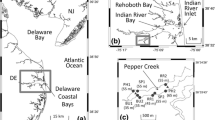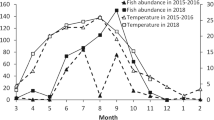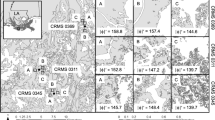Abstract
The mummichog,Fundulus heteroclitus, is one of the most important macrofaunal components of salt marsh surfaces and an important link to subtidal areas of the adjacent estuary along the east coast of the U.S. We estimated growth, population size, and production of the mummichog in a restored marsh in order to improve our understanding of the role of this resident fish and to evaluate the success of the restoration. The restored marsh, covering 234 ha, was a former salt hay farm located in the mesohaline portion of Delaware Bay that was restored to tidal influence in August 1996. We separated the mummichog population into two components based on life history stage and summer habitat use patterns. One component, consisting of adults and large young-of-the-year (YOY), exhibited tidal movements to and from the marsh surface and the subtidal creeks. These were examined with an intensive mark and recapture program using coded wire tags. Another component, consisting of small YOY, remained on the marsh surface throughout the tidal cycle. Throw traps were used to sample these small YOY. The mean annual population density of adults and large YOY for the entire marsh was approximately 1.2 fish m−2 and mean monthly density peaked at 2.9 fish m−2. The mean annual density of small YOY on the marsh surface was 15.1 fish m−2 and mean monthly density peaked at 41.4 fish m−2. Size and season influenced the growth rate of individual fish and instantaneous growth rates ranged from 0.03 to 2.26 mo−1. Total annual mummichog production was estimated to be 8.37 g dw m−2 yr−1, with adults and large YOY contributing 28.4% (2.38 g dw m−2 yr−1) and small YOY on the marsh surface contributing 71.6% (5.99 g dw m−2 yr−1). The seasonal use and population densities were comparable to previous studies in natural marshes while growth and production of mummichog in this restored marsh appeared to be higher. Coupled with the results of other studies on the feeding, movement, and habitat use of this species in this restored marsh, the species has responded well to the restoration.
Similar content being viewed by others
Literature Cited
Able, K. W. 1999. Measures of juvenile fish habitat quality: Examples from a National Estuarine Research Reserve.American Fisheries Society Symposium 22:134–147.
Able, K. W. andS. M. Hagan. 2000. Effects of common reed (Phragmites australis) invasion on marsh surface macrofauna: Response of fishes and decapod crustaceans.Estuaries 23:633–646.
Able, K. W., D. M. Nemerson, P. R. Light, andR. O. Bush. 2000. Initial response of fishes to marsh restoration at a former salt hay farm bordering Delaware Bay, p. 749–773.In M. P. Weinstein and D. A. Kreeger (eds.), Concepts and Controvversies in Tidal Marsh Ecology. Kluwer Academic Publishers, Dordrecht, The Netherlands.
Able, K. W., D. A. Witting, R. S. McBride, R. A. Rountree, andK. J. Smith. 1996. Fishes of polyhaline estuarine shores in Great Bay—Little Egg Harbor, New Jersey: A case study of seasonal and habitat influences, p. 335–353.In K. F. Nordstrom and C. T. Roman (eds.), Estuarine Shores: Evolution, Environments and Human Alterations. John Wiley and Sons, Chichester, England.
Boesch, D. F. andR. E. Turner. 1984. Local movements inMenidia andFundulus.Copeia 1960:139–141.
Chitty, J. D. 2000. The response of a resident marsh killifish,Cyprinodon variegatus, to marsh restoration in southern New Jersey. Master’s Thesis, Rutgers University, New Brunswick, New Jersey.
Deegan, L. A. 1993. Nutrient and energy transport between estuaries and coastal marine ecosystems by fish migration.Canadian Journal of Fisheries and Aquatic Sciences 50:74–79.
Jolly, G. M. 1965. Explicit estimates from capture-recapture data with both death and immigration-stochastic model.Biometrika 52:225–247.
Kneib, R. T. 1986. The role ofFundulus heteroclitus in salt marsh trophic dynamics.American Zoologist 26:259–269.
Kneib, R. T. 1993. Growth and mortality in successive cohorts of fish larvae within an estuarine nursery.Marine Ecology Progress Series 94:115–127.
Kneib, R. T. 1997a. The role of tidal marshes in the ecology of estuarine nekton.Oceanography and Marine Biology 35:163–220.
Kneib, R. T. 1997b. Early life stages of resident nekton in intertidal marshes.Estuaries 20:214–230.
Kneib, R. T. andS. L. Wagner. 1994. Nekton use of vegetated marsh habitats at different stages of tidal inundation.Marine Ecology Progress Series 106:227–238.
Kushlan, J. A. 1981. Sampling characteristics of enclosure fish traps.Transactions of American Fisheries Society 110:557–562.
McIvor, C. C. andW. E. Odum. 1988. Food, predation risk, and microhabitat selection in a marsh fish assemblage.Ecology 69: 1341–1351.
Meredith, W. H. andV. A. Lotrich. 1979. Production dynamics of a tidal creek population ofFundulus heteroclitus (Linnaeus).Estuarine and Coastal Marine Science, 8:99–118.
Morin, A., T. A. Mousseau, andD. A. Roff. 1987. Accuracy and precision of secondary production estimates.Limnology and Oceanography 32:1342–1352.
Nemerson, D. M. 2001. Trophic dynamics and habitat ecology of the dominant fish of Delaware Bay (USA) marsh creeks. Ph.D. Dissertation, Rutgers University, New Brunswick, New Jersey.
Nixon S. W. andC. A. Oviatt. 1973. Ecology of a New England salt marsh.Ecological Monographs 43:463–498.
PSE&G. 1999. Public Service Electric and Gas Company Detrial Production Monitoring. PSE&G Estuary Enhancement Program, Publication 99030. Newark, New Jersey.
Ricker, W. E. 1975. computation and interpretation of biological statistics of fish populations.Bulletin of the Fisheries Research Board of Canada 191:382.
Roman, C. T., W. A. Niering, andR. S. Warren. 1984. Salt marsh vegetation change in response to tidal restriction.Environmental Management 8:141–150.
Rountree, R. A. andK. W. Able. 1992. Fauna of polyhaline subtidal marsh creeks in southern New Jersey: Composition, abundance and biomass.Estuaries 15:171–185.
Rozas, L. P. andT. J. Minello. 1997. Estimating densities of small fishes and decapod crustaceans in shallow estuarine habitats: A review of sampling design with focus on gear selection.Estuaries 20:199–213.
Seber, G. A. F. 1965. A note on the multiple-recapture census.Biometrika 52:249–259.
Seber, G. A. F. 1973. The Estimation of Animal Abundance and Related Parameters. Hafner Press, New York.
Sebold, K. R. 1992. From Marsh to Farm: The Transformation of Coastal New Jersey. New Jersey Coastal Heritage Trail, National Park Service, U.S. Department of the Interior, Washington, D.C.
Smith, K. 1995. Processes regulating habitat use by salt marsh nekton in a southern New Jersey estuary. Ph.D. Dissertation, Rutgers University, New Brunswick, New Jersey.
Smith, K. J., G. Taghon, andK. W. Able. 2000. Trophic linkages in marshes: Ontogenetic changes in diet for young-of-the-year mummichog,Fundulus heterolitus, p. 221–237.In M. P. Weinstein and D. A. Kreeger (eds.), Concepts and Controversies in Tidal marsh Ecology. Kluwer Academic Publishing, Dordrecht, The Netherlands.
Sogard, S. M. 1997. Size-selective mortality in the juvenile stage of teleost fishes: A review.Bulletin of Marine Science 60:1129–1157.
Sogard, S. M. andK. W. Able. 1991. A comparison of eelgrass, sea lectuce macroalgae, and marsh creeks as habitats for epibenthic fishes and decapods.Estuarine, Coastal and Shelf Science 33:501–520.
Talbot, C. W. andK. W. Able. 1984. Composition and distribution of larval fishes in New Jersey high marshes.Estuaries 7:434–443.
Teal, J. M. 1962. Energy flow in the salt marsh ecosystem of Georgia.Ecology 43:614–624.
Teo, S. L. H. 1999. Movement and population dynamics of the mummichog,Fundulus heteroclitus, in a restored salt marsh. Master's Thesis, Rutgers University, New Brunswick, New Jersey.
Teo, S. L. H. and K. W. Able. In press. Habitat use and movement of the common mummichog (Fundulus heteroclitus) in a restored salt marsh.Estuaries.
Tupper, M. andK. W. Able. 2000. Movements and food habits of striped bass (Morone saxatilis) in Delaware Bay (USA) salt marshes: Comparison of a restored and a reference marsh.Marine Biology 137:1049–1058.
Unwin, M. J., J. T. Hill, andD. H. Lucas. 1997. An accurate and efficient method for reading sequentially coded wire tags aided by a PC-based data capture program.North American Journal of Fisheries Management 17:446–450.
Valliela, I., J. E. Wright, J. M. Teal, andS. B. Volkmann. 1977. Growth, production and energy transformations in the salt marsh killifishFundulus heteroclitus.Marine Biology 40:135–144.
Weinstein, M. P. 1979. Shallow marsh habitats as primary nurseries for fishes and shellfish, Cape Fear River, North Carolina.Fishery Bulletin 77:339–357.
Weinstein, M. P., J. H. Balletto, J. M. Teal, andD. F. Ludwig. 1997. Success criteria and adaptive management for a largescale wetland restoration project.Wetlands Ecology and Management 4:111–127.
Weinstein, M. P., L. Scott, S. P. O'Neill, R. C. Siegfried, II, andS. T. Szedlmayer. 1984. Population dynamics of spot,Leiostomus xanthurus, in polyhaline tidal creeks of the York River estuary, Virginia.Estuaries 7:444–450.
Weisberg, S. B. andV. A. Lotrich. 1982. The importance of an infrequently flooded intertidal marsh surface as an energy source for the mummichogFundulus heteroclitus: An experimental approach.Marine Biology 66:307–310.
Williams, G. D. andJ. B. Zedler. 1999. Fish assemblage composition in constructed and natural tidal marshes of San Diego Bay: Relative influence of channel morphology and restoration history.Estuaries 22:702–716.
Wright, J. H. 1972. Growth, mortality, production and consumption of a population of the salt marsh killifish,Fundulus heteroclitus (Linnaeus) Masters Thesis, Boston University, Boston, Massachusetts.
Source of Unpublished Materials
Valiela, I. Personal Communication. Marine Biological Laboratory, Woods Hole, Massachusetts 02543.
Author information
Authors and Affiliations
Corresponding author
Rights and permissions
About this article
Cite this article
Teo, S.L.H., Able, K.W. Growth and production of the mummichog (Fundulus heteroclitus) in a restored salt marsh. Estuaries 26, 51–63 (2003). https://doi.org/10.1007/BF02691693
Received:
Accepted:
Issue Date:
DOI: https://doi.org/10.1007/BF02691693




